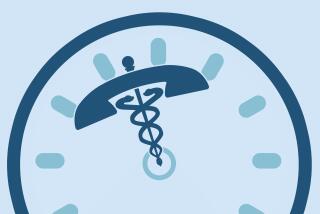Disparity in Elderly Health Care Reported : Medicare: Study says low-income areas have far higher hospital admissions for preventable conditions.
- Share via
Even with Medicare coverage, there are large and potentially life-threatening disparities in hospital admission patterns between rich and poor, rural and urban, and among black, Latino and white populations in Los Angeles County, a new study showed Thursday.
The study, by the Los Angeles-based Center for Health Care Rights, found that people age 65 and over who live in low-income communities, particularly African Americans, are more likely than their counterparts in high-income areas to be hospitalized for medical conditions that could have been avoided with good preventive or primary care.
At the same time, the study showed that high-income elderly people living on the Westside, as well as the state’s elderly population as a whole, were significantly more likely than low-income African Americans and Latinos to undergo hip replacement, mastectomy and coronary bypass surgeries, where physician referrals are important.
“The study findings indicate that the provision of health care is not colorblind,” said Geraldine Dallek, the executive director of the center and author of the report.
The report will not be officially released until today, but a copy was obtained in advance by The Times.
What makes the study particularly noteworthy is that the population studied is insured through Medicare, a federally financed health care system that provides a uniform package of benefits to nearly everyone age 65 or older.
The study concluded that the red, white and blue Medicare card, which it called elderly peoples’ “passport to virtually all physicians and hospitals in this country,” in fact “does not buy equal access to health care in Los Angeles County.”
It said access problems were experienced by all low-income elderly people in the county, but especially among blacks and Latinos. The center did not cite reasons for the problem, but suggested a range of shortcomings, such as a shortage of physicians in low-income communities, a higher likelihood of disease or disability in poorer areas, inadequate home care and high out-of-pocket expenses for medical services and drugs that are not covered by Medicare.
The center, previously known as the Medicare Advocacy Project, is an advocacy group for Medicare recipients with a history of doing exhaustive research into the health care system.
The new study is further confirmation of evidence that has turned up in many other studies by academic and health researchers showing that there is a division along economic, racial and ethnic lines in the distribution of health care services that contributes to higher death and morbidity rates in low-income areas.
*
The results also raise questions about one of the underlying premises of national health care reform, which is that providing all Americans with health insurance cards will solve many of the nation’s health care distribution problems.
“This shows that it is not enough just to furnish a health insurance card to people. You have to address other problems in the health care delivery system,” Dallek said.
Dallek said she finds Los Angeles County a perfect place for comparative health studies because of its vast geographic area, its diverse ethnic and racial mix, and the clearly defined wealthy and impoverished communities. She generated the numbers in the new study by dividing the county into 65 hospital market areas. The study analyzed age- and sex-adjusted hospital admission rates in 1990 and 1991 in Los Angeles County and compared them to those of the state.
She found that in Watts, where 77% of the elderly population is black, Medicare recipients were 57% more likely than the state’s Medicare population as a whole to be hospitalized for gastroenteritis, 76% more likely to be hospitalized for kidney or urinary tract infections, 85% more likely to be hospitalized for asthma, 210% more likely to be hospitalized for congestive heart failure and diabetes and 451% more likely to be hospitalized for hypertension. All of these conditions can be treated on an outpatient basis with preventive care.
Using the same comparisons with the statewide Medicare population, the study found that elderly people in the high-income, predominantly white Santa Monica area were significantly less likely to be hospitalized for those conditions.
*
On the question of surgeries, in the low-income, predominantly Latino community of Boyle Heights, elderly people were 45% less likely than the state’s elderly population as a whole to undergo a hip joint replacement, 29% less likely to undergo a mastectomy, 21% less likely to receive a coronary artery bypass and 39% less likely to undergo a coronary angioplasty.
In Los Angeles’ predominantly white Westside, elderly people were 34% more likely to undergo a coronary artery bypass and 50% more likely to receive a coronary angioplasty, the study found.
David Langness, a spokesman for the Hospital Council of Southern California, said: “We’ve known for a long time that people in poor neighborhoods are hospitalized more often because they tend not to have a primary care physician or go in for for regular checkups and care. Their conditions worsen until they need hospital care.”
Dr. Leonard Lawrence, president of the National Medical Assn., an association of black physicians, and an associate dean at the University of Texas Health Science Center in San Antonio, said he did not think issues raised in the study “are that unique” to Los Angeles County.
“Access means more than a card or a clinic. It means people being able to come into a care-giving system,” he said.
Langness said he found the statistics on surgeries surprising, and was at a loss to explain possible reasons. He said the study “raised some serious questions that we will have to examine.”
More to Read
Sign up for Essential California
The most important California stories and recommendations in your inbox every morning.
You may occasionally receive promotional content from the Los Angeles Times.













